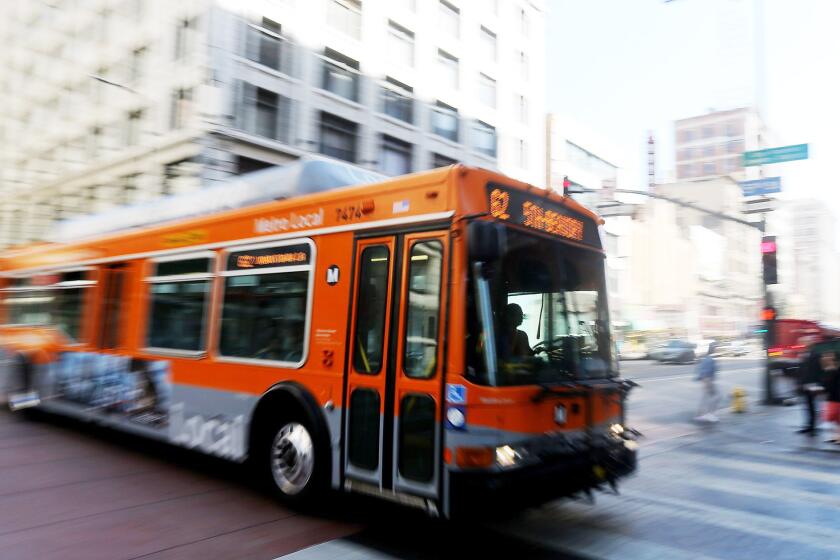Development Along Rail Lines
- Share via
I disagree with “It’s Time for L.A. to Grow Up,” by Gloria Ohland (Opinion, Aug. 4). I love living in Thousand Oaks, far from urban congestion, and I certainly do not want to give up my privacy and time to brush shoulders with a bunch of strangers on a train. I’d rather spend more time and money driving on the congested freeways, because it is private and comfortable and almost always faster than taking Metrolink or Metro Rail.
Unfortunately for suburbanites, the transportation powers and decision makers work in downtown L.A. at Caltrans and the Metropolitan Transportation Authority, and their perspectives and planning are distorted by their environment.
Frank Randak
Thousand Oaks
*
Ohland’s opinion piece offers interesting food for thought about urban design in an automobile-dependent metropolitan area. Her message is similar to that of the Urban Land Institute advisory panel that visited Hollywood in March 2001, underwritten in part by my nonprofit planning company, the American City Coalition. Among recommendations in the panel’s report, “A Strategy for Hollywood’s Comeback,” is to “leverage the power of mass transit,” for the subway system is a powerful resource for the community.
Hollywood and other communities can advance their revitalization efforts through transit-oriented design and public transportation incentives. In terms of development strategies, the panel report suggests the creation of a transit overlay district to maximize development potential around the subway stations; doing so also would stimulate use of the system.
The ULI Hollywood report suggests a list of tools that aid in the implementation of transit-oriented development: (1) A market-based site and phasing plan; (2) land assembly sufficient to make a project economically viable; (3) infrastructure investment; (4) shared parking; (5) expedited permits and reviews; (6) direct financial participation on the part of the city or the appropriate public authority, including the issuance of tax-exempt bonds, low-interest loans, loan guarantees and/or equity participation. Though directed to Hollywood revitalization, these points have salience to other neighborhoods mentioned in Ohland’s article as L.A. attempts to grow up.
The MTA is to be commended for taking baby steps in the direction suggested by Ohland and the ULI Hollywood report. I suggest the MTA needs to be even more aggressive on the question of density to begin walking upright on the transit-oriented development issue. Given the housing and traffic congestion crises in Los Angeles and Ohland’s sense that well-designed projects and increased density can make neighborhoods more attractive, I encourage the MTA to consider more density than it seems to be comfortable with.
Philip S. Hart
Los Feliz
*
In 1980 and 1990, the Los Angeles County Transportation Commission sold local sales tax propositions to the electorate by promising that a new rail system would decongest Los Angeles roads. Ohland is just repeating this old lie. In truth, fewer than 5% of Los Angeles work trips occur on transit, and the great majority of these trips occur on buses. Rail’s share of travel in Los Angeles is tiny, and neither the Gold Line nor transit-oriented development will make this drop in the bucket appreciably larger. L.A. transit ridership was close to 500 million annual boardings in 1985.
After more than 15 years of population growth and $7.5 billion in rail expenditures, L.A. transit ridership has been reduced to a level near 400 million annual boardings. Expensive rail systems serve few, reduce bus service and make congestion worse, not better.
James E. Moore II
Professor of Civil Engineering,
Public Policy & Management
USC
*
Ohland tells us that “building of such housing along transit lines is ideal, since residents wouldn’t have to own cars.... “ Did Ohland fall out of a tree? Does she ride a bike in the fast lane? She surely can’t live in Los Angeles. Does anyone believe this stuff?
Ms. Ohland, set an example. Sell your car and a year later tell us how great it was.
Richard Shilling
Pacific Palisades
More to Read
Sign up for Essential California
The most important California stories and recommendations in your inbox every morning.
You may occasionally receive promotional content from the Los Angeles Times.










